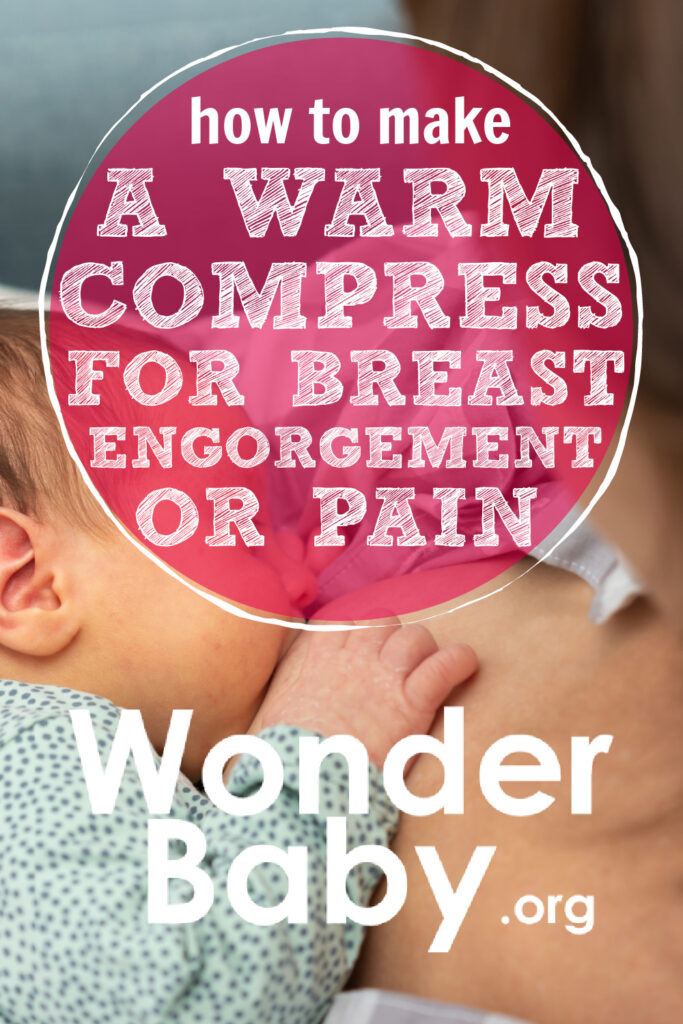How to Make a Warm Compress for Breast Engorgement or Pain

- Breast engorgement occurs when the breast tissue becomes overly full of milk.
- Breast engorgement usually occurs three to five days after birth but can occur at any time throughout the breastfeeding journey.
- Pain from breastfeeding may be due to breast engorgement, cracked or chapped nipples, a clogged milk duct, or a breast infection, also known as mastitis.
- Applying a warm compress to your breasts may help relieve breast engorgement and pain.
- Some women may never experience breast engorgement while breastfeeding.
Most breastfeeding mothers have experienced breast engorgement or pain while nursing or even during pregnancy. Breast engorgement is common in the early days or weeks of breastfeeding as colostrum transitions into mature breast milk.
Breast engorgement causes your breasts to feel tender, heavy, swollen, and hot. Although uncomfortable, breast fullness in the early days of breastfeeding indicates a good milk supply for your baby. Breast engorgement is best relieved by frequent nursing sessions or nursing your baby on demand. New moms should feed their baby every 2-3 hours to help ease engorgement.
Engorgement can also occur if you are not removing milk completely from the breasts with each feeding. If milk is not properly removed from the breasts, you may develop a plugged milk duct, which causes milk to back up into the milk ducts and cause pain and, in some cases, an infection called mastitis.
Breast engorgement may not be avoidable in the first few weeks of breastfeeding, but you can improve the experience by making a warm compress for breast engorgement and pain at home.
Warm Compress for Breast Pain: Is It Effective?
YES! Warm compresses are an effective and convenient way to relieve breast engorgement and breast pain. In addition, the heat from the warm compress can help to soften the breasts and stimulate the milk ducts to release more milk.
Warm compresses can also be an effective tool in relieving clogged milk ducts. The heat can help soften the breasts and the plugged milk, which can decrease inflammation and help the milk flow from the breasts more easily. A warm compress can also help to relieve the symptoms of mastitis.

How to Make a DIY Warm Compress for Breasts at Home
Warm compresses can relieve pain and engorgement while breastfeeding, no matter what the cause may be. Here are five easy ways to make a warm compress with items you have in your home.
- A warm washcloth: Take a clean washcloth and soak it in warm/hot water. Once the cloth is saturated, wring out the excess water and apply it to your breasts for 15-20 minutes. Moist heat is most effective in alleviating pain and engorgement from the breasts. If you want to make a reusable warm compress, place the washcloth in a small plastic bag with a zipper and reheat it in the microwave whenever you need it.
- A sock filled with rice or beans: For this method, you will need an old clean sock and dried rice or beans. Fill the sock with dried rice or bean and tie off the end. Next, microwave the full sock for 30-second intervals turning it each time until it reaches the right temperature. Once you have the DIY compress sock, you can reuse it whenever you like. You can even use it on other body parts like your neck or back to relieve muscle tension.
- Diaper method: Even though it may sound crazy, one of the most convenient ways to make a warm compress for your breast is to use one of your baby’s diapers. Run the diaper under hot water, wring out any extra water and apply to your breast. You can also use cold water and microwave the diaper for 30-45 seconds until it reaches the right temperature. The diaper can easily be molded to fit the shape of your breast and can be held in place with your bra. Using a diaper is very convenient for new moms, because they are readily available, so you won’t need to go out of your way to collect supplies.
- Water bottle: Fill a plastic bottle with water and microwave in 30-second intervals until heated evenly throughout. Once heated, you can apply the water bottle to your breast. Using a water bottle has some limitations to consider. It is not flexible, so it can be difficult to mold to your breast or hold it in place, but you can use it in a pinch.
- A warm shower: Warm showers are an excellent alternative treatment for warm compresses. Standing in a warm shower can help relieve engorgement and pain and relieve muscle tension and stress. While in the shower, you can massage your breasts or hand express a small amount of milk to help soften your breasts and stimulate your milk supply.
How to Treat Painful And Engorged Breasts With a Warm Compress
Heat can be applied to the breast whenever you are feeling discomfort. Many mothers like to use heat on their breasts before they nurse their baby to help relieve swelling and tension and promote the milk to flow more easily from the breasts. Follow these simple steps to apply heat to your breasts.
- Prepare your compress. You may need to add warm/hot water to your compress or microwave it until it reaches the right temperature.
- Test the temperature of the compress on the inside of your wrist to ensure it is not too hot before applying it to your breasts.
- Place the compress on your breasts. It may be helpful to hold the compress in place with your bra.
- Leave the compress in place for 15-20 minutes at a time. If the compress becomes too warm or causes discomfort, make sure to remove it immediately to prevent burning or irritation to the sensitive skin of your nipple or areola.
- Once the compress has been removed, make sure not to apply it again for 20-30 minutes to avoid irritating the skin.
- Use the warm compress as often as you want throughout the day to help relieve pain and swelling and promote breast milk production.

Safety Precautions When Using a Warm Compress
Breasts are naturally sensitive, and while engorged, they can be even more sensitive. Here are some helpful tips and safety precautions to consider when applying a warm compress to your breasts.
- Ensure the compress is not too hot, so you do not burn the sensitive skin of your breast, areola, or nipples. You can test the temperature on your wrist first.
- Only apply heat to your breasts for 15-20 minutes at a time, and take breasts in between applications, so you do not cause any skin irritation.
- Ensure not to fall asleep or leave the compress on for too long to avoid skin irritation or burns.
- If the skin of your breast has a rash, cut, or other irritation, do not apply a warm compress to that area.
- If you develop flu-like symptoms with breast engorgement, speak with your doctor. You may have an infection caused by a plugged duct called mastitis.
Additional Tips to Help Relieve Engorged and Painful Breasts
Here are some other helpful tips to help relieve engorged or painful breasts.
- Massage your breasts before and during feedings to help breast milk flow easier.
- Electric heating pads can also be used as warm compresses. Just make sure it is not too hot, and you do not sleep with it in place to avoid burns.
- Get to know your baby’s hunger cues and nurse your baby on demand. Nursing your baby frequently can help reduce swelling and tenderness and help you to produce more milk for your baby.
- If your breast is so engorged that your nipple has flattened, and you are having difficulty latching your baby, it can be helpful to hand express some milk before you feed your baby to soften the breast and nipple.
- Over-the-counter medications like ibuprofen can help relieve discomfort from engorgement and make nursing your baby more comfortable. Always speak to your doctor before taking medications when breastfeeding.
- To relieve pain from engorgement in between nursing sessions, you can use an electric breast pump or hand pump to remove a small amount of milk. However, make sure not to remove too much milk at a time, so you do not stimulate your breasts to make more milk than your baby needs.
- If you have concerns while breastfeeding, consider meeting with a lactation consultant in your area.
- Some breastfeeding moms find that a cold compress or cold packs can help relieve breast discomfort. Apply the ice packs to your breast for 15-20 minutes at a time.

Related Posts

Breastfeeding, Sleep
Sleep and Breastfeeding: A Comprehensive Guide for Nursing Moms
Many people assume breastfeeding and sleep training don’t go together, but it is possible to help your baby sleep better while continuing your breastfeeding journey.

Breastfeeding
Comfort Nursing: Pros, Cons, and How to Stop
Find out what comfort nursing is, when should you worry about it, and how to stop or limit your baby's comfort nursing (especially at night!).

Breastfeeding, Product Reviews
5 Best Breastfeeding Chairs for Nursing Moms of 2023
Whether you want a gentle rock, a smooth glide, or a cozy cuddle to soothe your baby to sleep, you’ll have your pick of the best breastfeeding chairs on the...